Mauz from Kicker had this interesting paperweight laying around the shop for awhile over at Monolith Press, where I work my day job. Turns out, it used to make noise. This was a remnant of the eighties, a Gallien-Krueger GK 400RG in all its solid-state and rack-mountable glory. It had its own crusty history as the amp for Geoff Evans from Skaven followed by Mauz when he recorded guitar for Dystopia’s “The Aftermath.” It also had a history of blowing up and some questionable, tweaky repairs with non-spec parts.
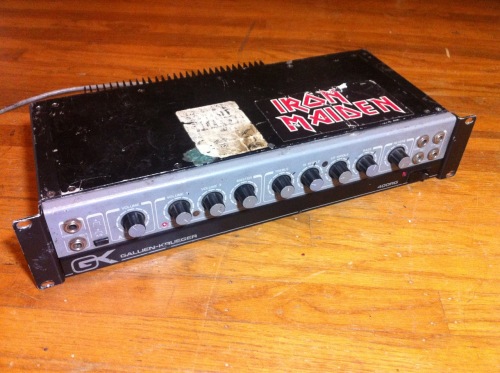
Mauz asked if I would take a looksy, so it went from a paperweight at the shop to a paperweight in my room. I wasn’t jumping at the chance to work on it. Fixing solid-state amps is a bitch. There’s so many little things that could be wrong or blown and you can’t always see it. You actually have to be smart… or you can blindly test everything a gazillion times until you get it right. So, yeah, testing everything it is.
I don’t get a lot of time on my workbench anymore. Hell, I don’t even have a workbench. I have a drawing table that sometimes doubles as a workbench. So I thought why not forgo waiting for time at the workbench and test this thing on the fly in someone’s dim apartment with cats running around. The preamp was working, until I pulled out the multimeter and did something bad.
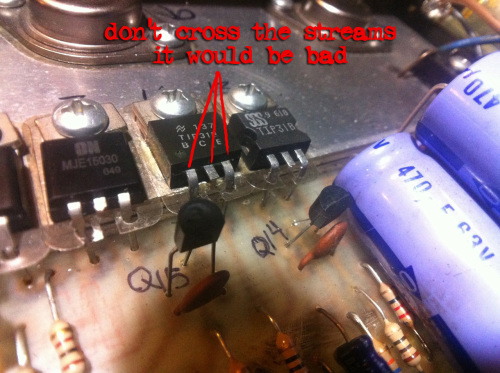
I clumsily shorted some points while testing voltages and probably sent about +60 volts down a a path meant to carry +15. What was connected to the +15 path? Oh, just every IC chip in the amp. That was a lot of juice and it shorted them all out.
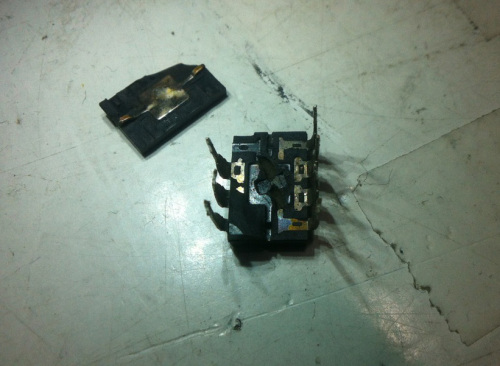
Now the preamp wasn’t working and I had a nifty lil’ fire happening in the power section of the amp. The GK 400RG is equipped with fusible resistors which are supposed to save the amp if there’s something shorts. They’re just normal 1/4 Watt 10Ω resistors that blowed up real good. I moved back to the workbench, another lesson in safety learned.
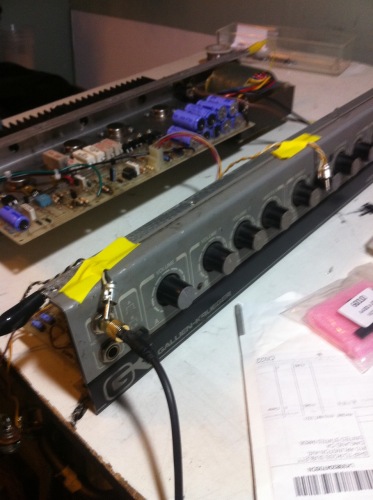
Unfortunately, this amp didn’t generate enough voltage in the short to use my light bulb limiter to check for a short. I had to continuously blow up the fusible resistors because I couldn’t think of a better way to do this. I socketed the whole lot of ICs so I could test them one by one and deduce which bastard was makin’ the ‘splosions. Put IC in, turn on amp, watch the fusible resistors CATCH FIRE.
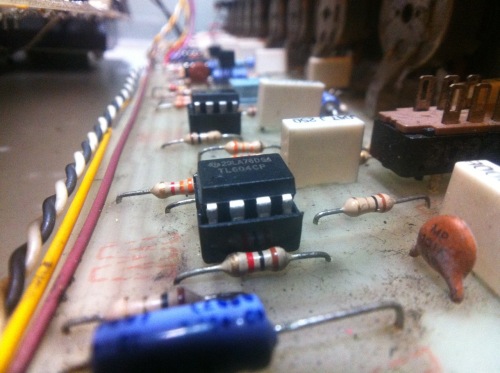
The culprit was one of the two TL604 switching ICs, one of which was blowing the power section. The GK 400RG has an A/B switch for two channels. The A channel has a decidedly bass-rich and vibrant clean tone, while the B channel has a terrible sounding overdrive. These ICs make the switch noiseless and are no longer made. Luckily, a dude on eBay from China was selling this very outdated part.
With the amp power stable and no more exploding resistors, I plugged an iPod into the amp and traced the audio. I used some headphones by connected the sleeve to the amps ground and the tip to a wire I could touch to the opamps output. They were all blown. ‘Cause I’m dumb and blew them all up. I replaced them all with some equivalents and the preamp was running again.
I moved back to the power amp. For looking through solid-state tech, I came up with a checklist for blow-up-itude. Diodes are first, then transistors, then ICs. Resistors should be last to blow. When they do, it’s almost (almost) always visible. I couldn’t find anything obviously in the power amp of the 400RG. After testing everything else a gazillion times, I finally thought, hey, ya know that big-assed resistor shoddily mounted in parallel on top of another resistor by a goof who didn’t have the desire to purchase the right parts to fix this correctly the first time? The one that is sticking out at me like a sore thumb? I wonder if that’s a problem.
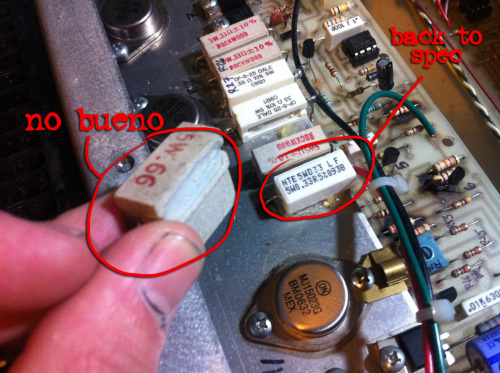
Whomever did this had managed to do his math correctly; he wired two resistors in parallel to make an equivalent resistance to what the schematic showed. Two high-wattage, hot resistors mounted on top of one another was a weak point, though. It didn’t have visible scorch marks, but it tested “bad.” Probably something to do with wattage, or amperage, or something smart I don’t fully understand. I replaced it and voilá, the amp was singing again.
Gallien-Krueger‘s customer service was very helpful and provided me with a manual and schematics. My genius, amp-building friend Max from Moldy Castle was also very kind to provide answers to my many queries. I couldn’t find much documentation online for the GK 400RG, so I’m providing what I have here in a convenient zip file.
GK400RG_documentation – 987 KB includes schematics and manual

Thanks for this write up… I just bought a GK400RG for my Daughter to use as a bass amp… pairing it with a SWR 4×10" speaker. She is 12 and just starting with her garage band career, so this is perfect. It was fun and interesting to read and the manual is very helpful.